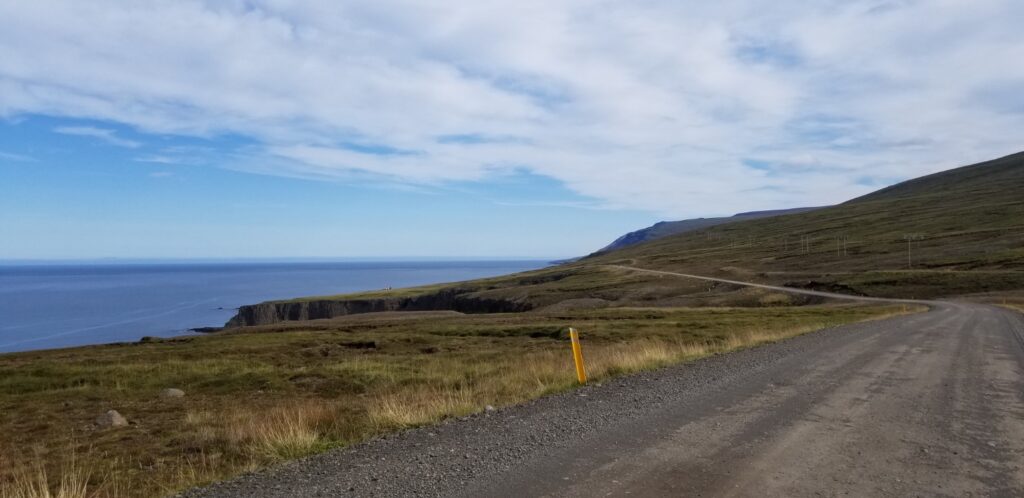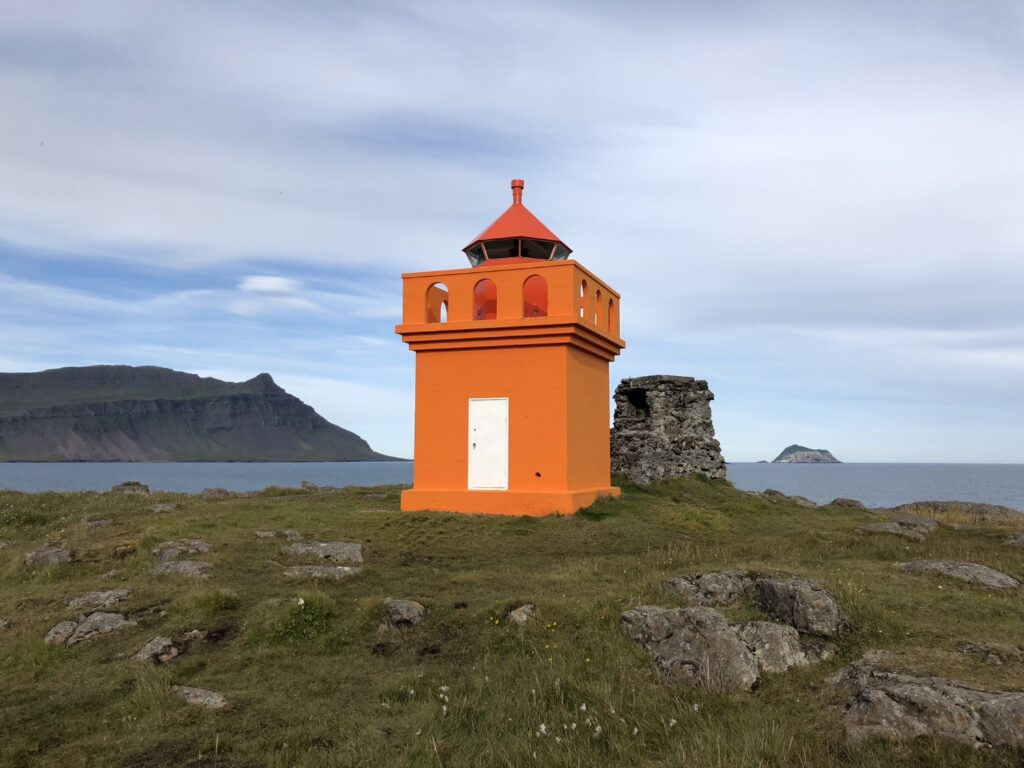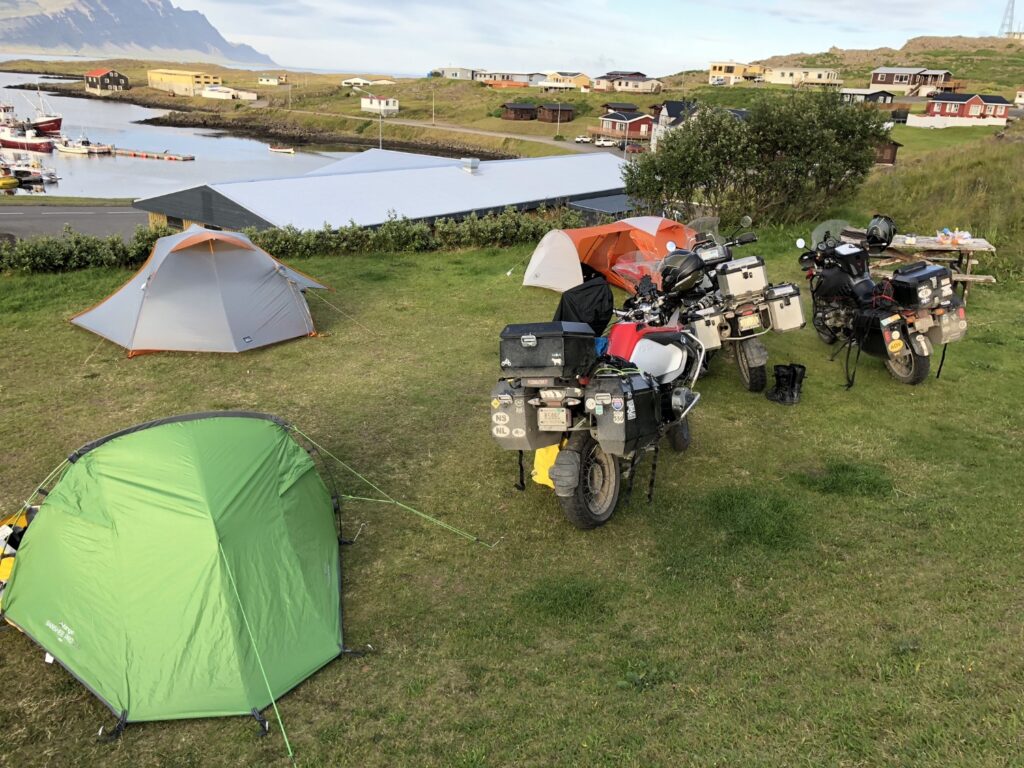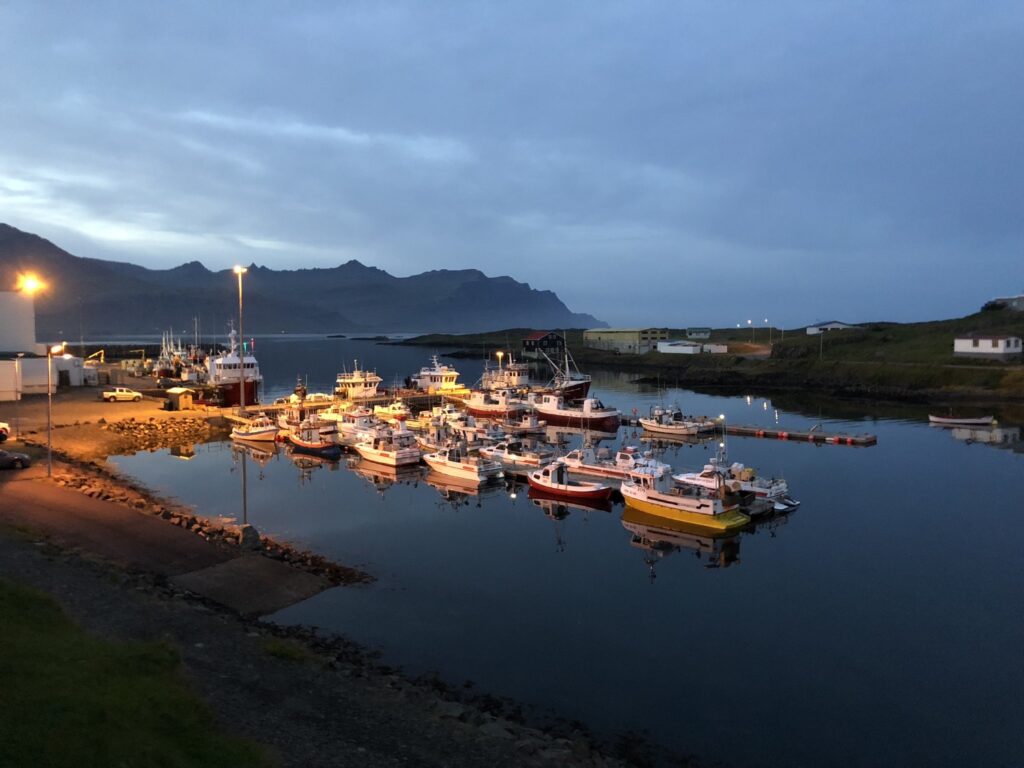Day 9 – Vopnafjörður to Djúpivogur and the East Fjords via Héraðssandur and Iceland’s amazing Route 917 – 180 miles
Note to self – Brennivin packs a punch the next morning.
We woke to a bright, sunny day and 58°. A perfect day to ride the East Fjords. Our spirits matched the greatly improved weather. It figures that the first day in a week we get a clear night and sunny morning, we slept indoors. Still it was a good sleep and having a hot shower and WC en suite is an appreciated luxury.
We met Jón, the son of the owners of the farm and cottages as we were packing up. He’s young, in his 20s, very well spoken, and eager to visit and share. He recently finished his education degree on-island and we hear about how many Icelanders, especially those going for more advanced degrees like medicine have to leave the island to complete their education. Predictably, most go to other Scandinavian countries. Jón was pleased to complete his degree without having to do that and he’s worked as a long-term sub while another teacher was off for maternity leave. He regaled us with stories of winter driving to Borgarnes on the other side of the island. We learn his great-grandfather bought the farm after serving in the postal service. That they have cattle for milk and beef. And 200 head of sheep. The success of the guest cottages they’ve built – surprising to them – will allow them to reduce their sheep herd by half. It seems most farmers here, like in Maine, have their hands in a number of businesses simultaneously.
Being Sunday, the local market is closed until noon (much to Warren’s disappointment) so we reluctantly scrap plans for a home-cooked breakfast before another late start to riding. We have 50+ miles of dirt and gravel today along route 917 over Dýjafjall. There are second gear switchbacks as we ascend then descend the very steep mountain, causing us to choose the view or watching the road so we don’t become a part of the view. Tough choice. The road is incredible. The most amazing in Iceland so far and arguably the best we’ve ever ridden.

There’s some deeper gravel while other sections are a bit muddy through small depressions in the rock. There’s no real water table here; since everything is rock, water pools where it wants. Still other sections have big, underlying ledge, the bones of the road, showing through. The bike handled it all great, over, around, and down the Héraðsflói where we’re again on a broad plain emptying to the bay. We follow the long, straight dirt road for miles back to the Ring Road, and I try to keep the bike under 60mph.
Once on the Ring Road we ride through another amazing valley created by runoff that becomes a gorge the farther east we go. The mountains looming around us look like broken teeth, something Tolkien would’ve drawn. They’re stepped and this is the first time we’ve seen a slant to the strata; they tilt up on their eastern side.

On the strand between water and the foot of the mountains we see more farms. And more turf houses – their walls being made of rock up to the eaves of the sharply slanted roof and the whole building being built into a small hill. The roof is covered with turf. The very practical design of these date to the Viking settlement; there was little wood then and none now, so they used what they could of local material.
Unexpectedly we also notice beached driftwood, a first this trip. Big, silver logs of trees broader than telephone poles are washed up on the rocky beaches. The must have come from Norway, maybe big spruces, as the prevailing current runs east to west along these shores.
It’s stunning weather today, almost warm! We stop at an well-equipped N1 in Egilsstaðir for pylsa and I pick up some “Viking Snak” for Duncan, basically dried, hard fish (harðfiskur) that at one time was a staple of the Icelandic diet. They have shrink-wrapped hákarl too but the label says it needs to be kept at 0-4° so I can’t get it back. And I thought it was already spoiled and preserved?
South out of Egilsstaðir and following the banks of the Lagarfljót we see birch forests for the first time. Some of the less filled-in areas indicate they’re being farmed, reseeded, by the neat lines. These are the only big trees we’ve seen and they’re not that big.


We wind our way in and out of the East Fjords at an easy pace. The ocean is incredibly blue here. Each fjord has a town, a bit out from the crux, facing south along the northern coast to capture as much sunlight and warmth as it can. Every village has the usual collection of red-roofed white houses, bright against green strand and blue sea, and a fish processing plant replete with docked brawny North Sea trawlers. Short, orange lighthouses dot each tip facing out to sea. Occasionally we see what resemble modern sculptures, a metal perforated disk on a tall pole, twinned, and theorize that’s for radar navigation, lining up an approach to the port in fog, much like twin lights used to along the East Coast of the US.
After another 6km long tunnel we find a postcard of a campsite in Djúpivogur with excellent facilities overlooking the snug harbour. Winds are calm from the south, the water flat. We stock up on snacks at the local market – the usual salmon, cheeses, rúgbrauð, and Icelandic butter. Having seen a couple cook them back in Mývatn, I pick up some kjøttboller, Swedish Meatballs, and sauce to cook that night. Been thinking about them for a couple of days. Dusk finally begins around 23h00.


Maybe Höfn or Vík tomorrow? Both are short rides away and we could’ve made them today but for being tired and finding this perfect campsite. We have plenty of time now that we’re rounding to the southern coast and are well ahead of David and Danny, who stayed two nights in Akureyri and another two in Mývatn.


